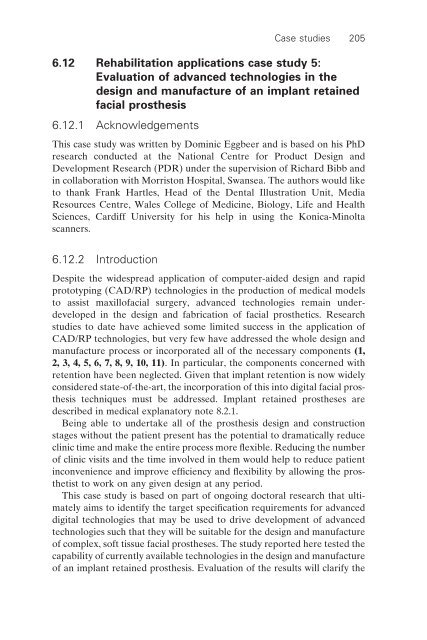R_Bibb_Medical_Modelling_The_Application_of_Adv.pdf
R_Bibb_Medical_Modelling_The_Application_of_Adv.pdf
R_Bibb_Medical_Modelling_The_Application_of_Adv.pdf
You also want an ePaper? Increase the reach of your titles
YUMPU automatically turns print PDFs into web optimized ePapers that Google loves.
Case studies 205<br />
6.12 Rehabilitation applications case study 5:<br />
Evaluation <strong>of</strong> advanced technologies in the<br />
design and manufacture <strong>of</strong> an implant retained<br />
facial prosthesis<br />
6.12.1 Acknowledgements<br />
This case study was written by Dominic Eggbeer and is based on his PhD<br />
research conducted at the National Centre for Product Design and<br />
Development Research (PDR) under the supervision <strong>of</strong> Richard <strong>Bibb</strong> and<br />
in collaboration with Morriston Hospital, Swansea. <strong>The</strong> authors would like<br />
to thank Frank Hartles, Head <strong>of</strong> the Dental Illustration Unit, Media<br />
Resources Centre, Wales College <strong>of</strong> Medicine, Biology, Life and Health<br />
Sciences, Cardiff University for his help in using the Konica-Minolta<br />
scanners.<br />
6.12.2 Introduction<br />
Despite the widespread application <strong>of</strong> computer-aided design and rapid<br />
prototyping (CAD/RP) technologies in the production <strong>of</strong> medical models<br />
to assist maxill<strong>of</strong>acial surgery, advanced technologies remain underdeveloped<br />
in the design and fabrication <strong>of</strong> facial prosthetics. Research<br />
studies to date have achieved some limited success in the application <strong>of</strong><br />
CAD/RP technologies, but very few have addressed the whole design and<br />
manufacture process or incorporated all <strong>of</strong> the necessary components (1,<br />
2, 3, 4, 5, 6, 7, 8, 9, 10, 11). In particular, the components concerned with<br />
retention have been neglected. Given that implant retention is now widely<br />
considered state-<strong>of</strong>-the-art, the incorporation <strong>of</strong> this into digital facial prosthesis<br />
techniques must be addressed. Implant retained prostheses are<br />
described in medical explanatory note 8.2.1.<br />
Being able to undertake all <strong>of</strong> the prosthesis design and construction<br />
stages without the patient present has the potential to dramatically reduce<br />
clinic time and make the entire process more fl exible. Reducing the number<br />
<strong>of</strong> clinic visits and the time involved in them would help to reduce patient<br />
inconvenience and improve effi ciency and fl exibility by allowing the prosthetist<br />
to work on any given design at any period.<br />
This case study is based on part <strong>of</strong> ongoing doctoral research that ultimately<br />
aims to identify the target specifi cation requirements for advanced<br />
digital technologies that may be used to drive development <strong>of</strong> advanced<br />
technologies such that they will be suitable for the design and manufacture<br />
<strong>of</strong> complex, s<strong>of</strong>t tissue facial prostheses. <strong>The</strong> study reported here tested the<br />
capability <strong>of</strong> currently available technologies in the design and manufacture<br />
<strong>of</strong> an implant retained prosthesis. Evaluation <strong>of</strong> the results will clarify the
















